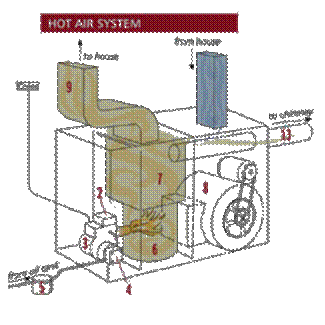


|
Call For Service 973-764-7327 |




|
We've included the diagrams on the right to help you understand the parts that make up your heating system. No matter which fuel your system uses, heat is distributed throughout your home in one of three ways: hot water (baseboard), steam (radiators) or warm air (vents). Two are described here. While the system you have may look a bit different, its operation is similar to those below. How Oil Systems Make Heat A fuel pump (4) draws oil through a filter (5) to your burner. It turns this oil into a fine spray, mixes it with air and ignites it in the combustion chamber (6), causing the chamber to get very hot. What happens next depends on the type of system you have. 1. If you have a Hot Water (hydronic) System (upper diagram), water circulates around your boiler's heat exchanger (10). A circulator (11) pumps the hot water through radiators or baseboards. An expansion tank (12) adjusts to varying pressures. 2. If you have a Warm Air System (lower diagram), air absorbs heat in your furnace's heat exchanger (7). A blower (8) sends this air through ducts (9) to heat your home. Eventually, the water or air returns to the unit and begins the cycle again. |
|
Steam systems work similarly. Rather than using a hot water circulator, steam vapor rises to the radiators. A low water cutoff prevents damage to the boiler by shutting it down if the water level drops too low. In all systems, the combustion emissions go up the flue (13), never mixing with either the air or water circulating through your home. |